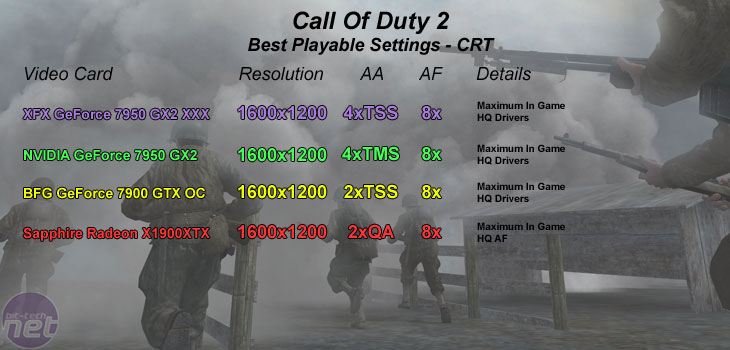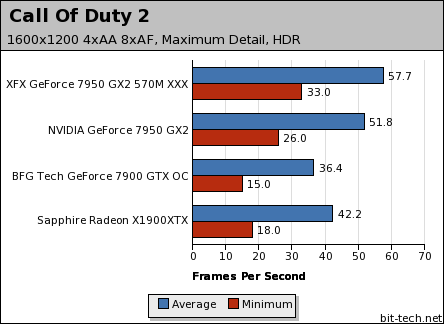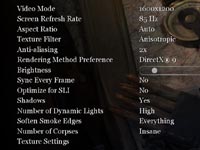For gameplay evaluations on a 24" widescreen monitor, please head straight to our widescreen performance section.
We used the full version of Call of Duty 2, patched to version 1.3. The game makes use of some awesome effects and is generally very graphically intense and immersive. That's helped by the tremendous smoke effect that Infinity Ward have created - it's better than anything we've ever seen before. There are also real time shadows and a subtle HDR lighting effect too.
The gameplay is not as linear as the first version of Call of Duty, and Infinity Ward has ditched the rather old Quake 3 engine in favour of creating its own proprietary graphics engine to render the effects. There is something about the game that makes it very intense and you often find yourself having to take a break from the action because you're too overwhelmed by its immersiveness and intensity.
We used a five minute portion of the first level in The Battle of El Alamein, starting the clock from the beginning of the battle, completing the missions in the same order, stopping the frame rate recording when we had played four minutes of the level. We ran this three times to check that our results were consistent.
The Optimise for SLI option was enabled on the GeForce 7950 GX2's and it was disabled on the BFG Tech GeForce 7900 GTX OC and Sapphire Radeon X1900XTX video cards.
Due to a problem with the Forceware 91.31 driver, we controlled anti-aliasing from the driver control panel on all NVIDIA video cards. When using the application's anti-aliasing controls, we experienced half the performance of 2xAA - using driver-controlled anti-aliasing set to 4x, we experienced frame rates closer to where we would expect using the in game controls. We checked image quality between the driver-controlled and application-controlled 4xAA and there was no noticeable difference.
We checked the performance of the Sapphire Radeon X1900XTX using both application managed and driver-controlled 4xAA, and the performance difference between the two was within our test error margins. The results reported here are the 'application controlled' results.

 The gaming experience delivered by the XFX GeForce 7950 GX2 570M XXX Edition card was pretty impressive, but then so was the performance delivered by the stock-clocked GeForce 7950 GX2's, too. The only difference in performance was the increased transparency anti-aliasing detail as a result of enabling transparency supersampling. Both video cards delivered a very impressive and immersive gaming experience.
The gaming experience delivered by the XFX GeForce 7950 GX2 570M XXX Edition card was pretty impressive, but then so was the performance delivered by the stock-clocked GeForce 7950 GX2's, too. The only difference in performance was the increased transparency anti-aliasing detail as a result of enabling transparency supersampling. Both video cards delivered a very impressive and immersive gaming experience.
Neither the Sapphire Radeon X1900XTX or BFG Tech GeForce 7900 GTX OC were fast enough to deliver smooth gameplay at 1600x1200 with 4xAA and maximum in game details enabled. If you want to play the game with 4xAA enabled on either card, you're going to have to make some in game detail compromises. We felt that the best settings for both cards was to enable 2xAA with either transparency supersampling or quality adaptive AA enabled. The performance difference between the two was marginal, but we would say that the Radeon X1900XTX delivered a slightly better experience.
 This was confirmed when we cranked the image quality up to 4xAA at the same resolution. The Sapphire Radeon X1900XTX was quite a bit faster than the BFG Tech GeForce 7900 GTX OC. However, neither card was fast enough to match the two GeForce 7950 GX2's - the XFX 570M XXX Edition was nearly six frames per second faster than the reference-clocked card.
This was confirmed when we cranked the image quality up to 4xAA at the same resolution. The Sapphire Radeon X1900XTX was quite a bit faster than the BFG Tech GeForce 7900 GTX OC. However, neither card was fast enough to match the two GeForce 7950 GX2's - the XFX 570M XXX Edition was nearly six frames per second faster than the reference-clocked card.
Call of Duty 2:
Publisher: ActivisionWe used the full version of Call of Duty 2, patched to version 1.3. The game makes use of some awesome effects and is generally very graphically intense and immersive. That's helped by the tremendous smoke effect that Infinity Ward have created - it's better than anything we've ever seen before. There are also real time shadows and a subtle HDR lighting effect too.
The gameplay is not as linear as the first version of Call of Duty, and Infinity Ward has ditched the rather old Quake 3 engine in favour of creating its own proprietary graphics engine to render the effects. There is something about the game that makes it very intense and you often find yourself having to take a break from the action because you're too overwhelmed by its immersiveness and intensity.
We used a five minute portion of the first level in The Battle of El Alamein, starting the clock from the beginning of the battle, completing the missions in the same order, stopping the frame rate recording when we had played four minutes of the level. We ran this three times to check that our results were consistent.
The Optimise for SLI option was enabled on the GeForce 7950 GX2's and it was disabled on the BFG Tech GeForce 7900 GTX OC and Sapphire Radeon X1900XTX video cards.
Due to a problem with the Forceware 91.31 driver, we controlled anti-aliasing from the driver control panel on all NVIDIA video cards. When using the application's anti-aliasing controls, we experienced half the performance of 2xAA - using driver-controlled anti-aliasing set to 4x, we experienced frame rates closer to where we would expect using the in game controls. We checked image quality between the driver-controlled and application-controlled 4xAA and there was no noticeable difference.
We checked the performance of the Sapphire Radeon X1900XTX using both application managed and driver-controlled 4xAA, and the performance difference between the two was within our test error margins. The results reported here are the 'application controlled' results.


Neither the Sapphire Radeon X1900XTX or BFG Tech GeForce 7900 GTX OC were fast enough to deliver smooth gameplay at 1600x1200 with 4xAA and maximum in game details enabled. If you want to play the game with 4xAA enabled on either card, you're going to have to make some in game detail compromises. We felt that the best settings for both cards was to enable 2xAA with either transparency supersampling or quality adaptive AA enabled. The performance difference between the two was marginal, but we would say that the Radeon X1900XTX delivered a slightly better experience.
Apples to Apples - 1600x1200 4xAA 8xAF


MSI MPG Velox 100R Chassis Review
October 14 2021 | 15:04








Want to comment? Please log in.